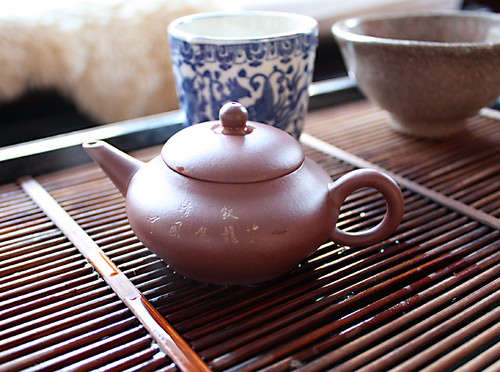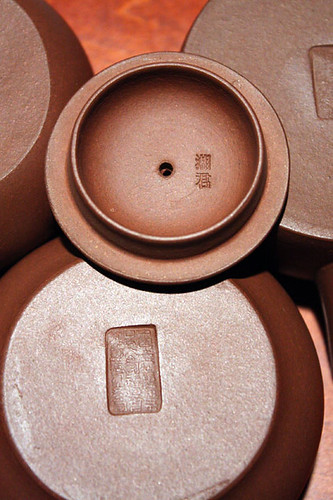So, how do you brew yours? Would it be wonderful to build a little archive for the new comers for some guide lines?
Here are some bottom lines I can throw out, and please feel free to chip in:
Leaves:
1. From which vendor, farmer, source.
2. Date of Harvest
3. Elevation
4. Soil based
5. Which area
6. Kind. eg: Wudong, cinnamon, honey, almond, orchid....etc
7. Fired level
8. Bush age
9. Grade
10. breathing tea before brewing
Brewing vessel, water:
1. Water source
2. Aged or fresh
3. How you boil your water
4. Temp. for the first 5 steeping
5. What kind of brewing vessel, eg: Aged yixing, what clay, size, shape. Giawan or tea bowl?
6. What kind of cup to drink from, eg: wide mouth, lotus cup, how old, what material....
Brewing Parameter:
Amount of leaves. Rinse time, set time, infusing time, Height of water pouring, hitting spots.... etc
Result of the brew:
Color, aroma, texture, mouth feel and effects of the brew, how many brews?
Weather:
Drinking time of the day, High/low humidity, rainy or sunny?
Brewer experience:
Here is what I had recently:


Leaves:
1. From which vendor, farmer, source: Man klan in Phoenix
2. Date of Harvest: 2005
3. Elevation: 1500m West
4. Soil based: Rock
5. Which area: Phoenix mountain range, near head.
6. Kind. eg: Wudong, cinnamon, honey, almond, orchid....etc: White leave
7. Fired level: light to medium 15%
8. Bush age: 200+yrs
9. Grade: 1st (only harvested in late April or early May) Once a year.
10. breathing tea before brewing: 3 days
Brewing vessel, water:
1. Water source: Poland Spring
2. Aged or fresh: 2 days
3. How you boil your water: Electric Water Boiler
4. Temp. for the first 5 steeping: shrimp eyes, rinse. 3 mins set for 1-5th brew.
5. What kind of brewing vessel, eg: Aged yixing, what clay, size, shape. Giawan or tea bowl? 80s yixing, wide bottom, only for light dc brewing. 120 ml.
6. What kind of cup to drink from, eg: wide mouth, lotus cup, how old, what material.... tall Japanese blue and white before WW2
Brewing Parameter:
Amount: half full
Rinse time: Flash
Set time: 30 sec
infusing time: Flash till 3rd then add 5 sec
Height of water pouring: chest level
Hitting spots: Rims around
Result of the brew:
Color: light burnt amber
Aroma: Honey, lychee, peach nectar, dry seaweed, roasted rice syrup candy, dough, little bite and stripping teeth.
Texture: almost full, clean
Mouth feel: Refreshing, awaken, sweet and floral at the back
Effects of the brew: Still a little bite, too less firing to age, cleansing.
How many brews: 8th stop, not too good for stomach....
Weather:
Drinking time of the day: Afternoon after snack
High/low humidity: 60s% hum, 40s temp
Rainy or sunny? mild with clouds
Brewer experience: 9 yrs.
Hope this is not boring.... : P
